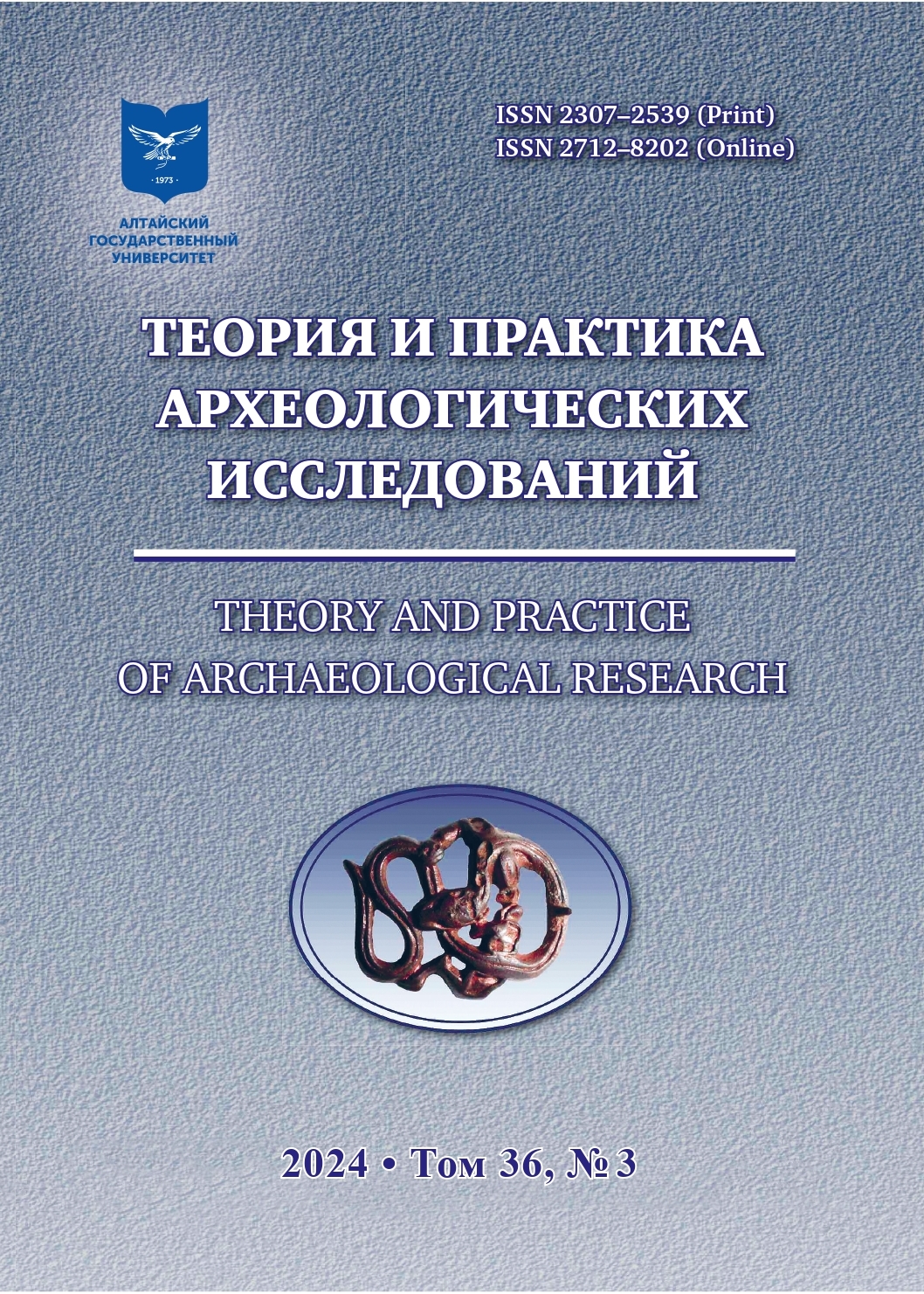THE LBISHCHE TYPE ARCHAEOLOGICAL SITES ON SAMARSKAYA LUKA. ANALYSIS OF THE SETTLEMENT STRUCTURE
Abstract
The article discusses the settlement structure of the Lbishche-type archaeological sites, dating from the 3rd to 4th centuries AD, located in the Samara Luka region. A GIS analysis was conducted both within the settlement structure of these sites and at the microregion level. To achieve this, all archival planigraphic data from previous research was compiled. Was created GIS database “Lbishche-type Sites”, which allowed the systematization of information from previous excavations. Analysis of artefact and object density demonstrated possible estate-type layout and trace the probable location of streets within the Lbishche site. Similar features of the Lbishche-type settlement layout were highlighted.
During the analysis of the settlement structure within the microregion, modeling of potential resource zones of sites was carried out, conclusions were drawn about the regularity of the placement of sites relative to water sources, visual communication, as well as the slope of the resource zones. The work was carried out on the basis of archival materials (archive of IA RAS) using the Esri ArcGIS software package (ArcMap).
Downloads
Metrics
No metrics found.
References
Bogachev A.V. Report on Archaeological Survey in the Stavropol District of the Kuibyshev Region in 1982 on an Archaeological Excavation Permit 592. Kujbyshev, 1983. 22 p. In: Archive of IA RAS. F. 1. S. 1. №8989. (In Russ.)
Vasiliev I.B. Report on the Excavation of the Lbishche Settlement in the Stavropol District of the Kuibyshevsk Oblast in 1983. Kujbyshev, 1986. 16 p. In: Archive of IA RAS. F. 1. S. 1. №10549–10549a. (In Russ.)
Vyazov L.A. Socio-economic Development of the Population of the Middle Volga Region in the Middle of the 1st Millennium AD: according to the Materials from the Imenkovo Culture: Dis. ... Cand. Hist. Sciences. Kazan, 2011. 393 p. (In Russ.)
Vyazov L.A., Asygaraeva G.S., Gismatulin M.R. A Study of the Archaeozoological Collection from the Ashna-Pando Hillfort in the Middle Sura Region. Stratum. Prirodnaya i kul’turnaya ejkumena = Stratum. Natural and Cultural Oecumene. 2021;4:125–141. (In Russ.)
Vyazov L.A., Salugina N.P., Semykin Y.A. Results of Research into Ceramics and Iron Objects from the Excavations of the Lbishche Hillfort in 2003. In: Local History notes. Samara : Samarskij oblastnoj istoriko-kraevedcheskij muzej im. P.V. Alabina, 2012. Pp. 34–69. (In Russ.)
History of the Samara Volga Region from Ancient Times to the Present Day. Early Iron Age and Middle Ages. Moscow : Nauka, 2000. 422 p. (In Russ.)
Kolonskikh A.G. Analysis of the Visibility of the Hillforts of the Bakhmutino Culture: GIS Capabilities and Field Research. In: Archaeology and Geoinformatics. Issue X. Moscow : Institut arheologii RAN, 2021. (In Russ.)
Korobov D.S. The Application of the 3D-Analyst for the Investigation of the Signalisation System of the Alans in the Kislovodsk Basin. In: Archaeology and Geoinformatics. Issue 3.Moscow : Institut arheologii RAN, 2006. (In Russ.)
Korobov D.S. Using ArcGIS Spatial Analyst for the Investigation of the System of Habitation in the Kislovodsk Basin (South of Russia). In: Archaeology and Geoinformatics. Issue 5. Moscow : Institut arheologii RAN, 2008. (In Russ.)
Korobov D.S. System of Habitation of the Alans of Central Ciscaucasia in the 1st Millennium AD: in 2 vol. Vol. 1: Landscape Archaeology of the Kislovodsk Basin. Moscow ; Saint Petersburg: Nestor-Istoriya, 2017. 384 p. (In Russ.)
Lifanov N.A. Early Medieval Residential Buildings of the Forest-Steppe Volga Region as a Source of Cultural and Genetic Reconstructions In: Legacy of A.P. Smirnov and Modern Problems of Archaeology of Volga and Kama Region. Moscow : GIM, 2000. Pp. 128–134. (In Russ.)
Mazhanova I.N. Report on the Survey in Samara Luka in 1974. Kujbyshev, 1977. 26 p. In: Archive of IA RAS. F. 1. S. 1. №5498. (In Russ.)
Matveeva G.I. Report on the Excavations of the Lbishche Hillfort in 1982. Kujbyshev, 1984. 38 p. In: Archive of IA RAS. F. 1. S. 1. №10118–10118a. (In Russ.)
Matveeva G.I., Report on the Excavation of the Lbishche Hillfort in 1983. Kujbyshev, 1984a. 33 p. In: Archive of IA RAS. F. 1. S. 1. №10119–10119a. (In Russ.)
Matveeva G.I. Report on the Excavations of the Lbishche Hillfort in 1984. Kujbyshev, 1985. 43 p. In: Archive of IA RAS. F. 1. S. 1. №11301–11301a. (In Russ.)
Matveeva G.I. Report on the Excavations of the Perevolok Hillfort in 1988 Kujbyshev, 1989. 22 p. In: Archive of IA RAS. F. 1. S. 1. №12935–12936. (In Russ.)
Matveeva G.I. Archaeological Sites of the Lbishche Type – the Early Stage of the Imenkovo Culture. In: Cultures of the Eurasian Steppes of the Second Half of the 1st Millennium AD (questions of chronology). Samara : SOIKM im. P.V. Alabina, 1998. Pp. 87–97. (In Russ.)
Matveeva G.I., 2003. Report on Excavations of the Lbishche Hillfort in 2002. Samara, 2003. 41 p. In: Archive of IA RAS. F. 1. S. 1. №27615. (In Russ.)
Matveeva G.I., Bogachev A.V., Nabokov A.V. Perevoloki Hillfort. In: 40 Years of the Middle Volga Archaeological Expedition. Local History Notes. Issue XV. Samara : Ofort, 2010. Pp. 231–242. (In Russ.)
Matveeva G.I., Vyazov L.A., Gasilin V.V., Lomeiko P.V., Serykh D.V., Skarbovenko V.A., Hohlov A.A. The Investigations of the Lbishche Hillfort in 2003. Voyadzher: mir i chelovek = Voyager: the World and Man. 2012;3:171–198. (In Russ.)
Noskova O.L., Rozenberg G.S. History of Building of the Kuibyshev Reservour. Izvestiya Samarskogo nauchnogo centra RAN = News of the Samara Scientific Center of the Russian Academy of Sciences. 2012;1(1):222–226. (In Russ.)
Obedeyntova G.V. From the Depths of Centuries. Geological History and Nature of Zhiguli. Kuibyshev : Kujbyshevskoe izdatel’stvo, 1988. 216 p. (In Russ.)
Petrenko A.G. On the History of Economic Activity of the Population of the Lower Kama Region of the 1st Millennium A.D. In: Cultures of the Eurasian Steppes of the Second Half of the 1st Millennium AD (questions of chronology). Samara : SOIKM im. P.V. Alabina, 1998. Pp. 198–212. (In Russ.)
Petrenko A.G. Formation and Development of the Foundations of Animal Husbandry in the History of the Peoples of the Middle Volga Region and the Urals (based on archaeozoological materials). Kazan : Institut istorii Akademii nauk Respubliki Tatarstan, 2007. 144 p. (In Russ.)
Petrov M.I. GIS-technologies in the Investigation of the Medieval Urban House-Hold (based on the Posolsky -2006 excavation area). In: Archaeology and Geoinformatics. Issue 6. Moscow : Institut arheologii RAN, 2010. (In Russ.)
Petrov M.I. GIS-technologies in Investigation of the Medieval Urban Household (based on the Posolsky-2006 excavation area). In: Brief Communications of the Institute of Archaeology. Issue 226. Moscow : Yazyki slavyanskoj nauki, 2012. Pp. 27–37. (In Russ.)
Petrov M.I. Medieval Novgorod Estate: Approach to Comparative Research (based on the Posolsky-2006 and Nikolsky-2007 excavation area in Novgorod). Novgorodskij istoricheskij sbornik = Novgorod Historical Articles. 2016;16(26):68–102. (In Russ.)
Rastoropov A.V. Report on the Archaeological Study of the Lbishche Hillfort for 1981. Kujbyshev, 1984. 51 p. In: Archive of IA RAS. F. 1. S. 1. №8562. (In Russ.)
Salugina N.P. Technology of Ceramics Production from the Lbishche Hillfort (according to the results of microscopic analysis). In: Cultures of Eastern Europe of the 1st Millennium. Kuibyshev : Kuibyshevskij gosudarstvennyj universitet, 1986. Pp. 105–117. (In Russ.)
Serykh D.V. Report on Archaeological Survey in the Stavropol Region of the Samara Oblast and the Ulyanovsk Region of the Ulyanovsk Oblast in 2013 Samara, 2014. 143 p. In: Archive of IA RAS. F. 1. S. 1. №41234–41235. (In Russ.)
Stashenkov D.A. Population of the Samara Forest-Steppe Volga Region of the 1st – 5th Centuries AD: Abstract Dis. … Сand. of Historical Sciences. Kazan, 2007. 25 p. (In Russ.)
Stashenkov D.A. On Chronological Relationship of Lbishche Type Sites and Early Complexes of the Imenkovo Culture. Izvestiya Samarskogo nauchnogo centra RAN = Izvestia of Samara Scientific Center of the Russian Academy of Sciences. 2010;12(6–38):272–275. (In Russ.)
Trebeleva G.V. Viewshed Analysis as a Method to Investigate the Defense System of the Taman Peninsula. In: Archaeology and Geoinformatics. Issue 3. Moscow : Institut arheologii RAN, 2006.
Chizhevskij A.A. Ceramics with a Matting Ornament from the Excavations of the Lbishche settlement in 2003. Povolzhskaya arheologiya = The Volga River Region Archaeology. 2012;2:211–217. (In Russ.)
Roberts B.K. Landscapes of Settlement. Prehistory to the Present. London : Routledge, 1996. 191 p.
Copyright (c) 2024 Л.Р. Халимуллина

This work is licensed under a Creative Commons Attribution 4.0 International License.
Theory and Practice of Archaeological Research is a golden publisher, as we allow self-archiving, but most importantly we are fully transparent about your rights.
Authors may present and discuss their findings ahead of publication: at biological or scientific conferences, on preprint servers, in public databases, and in blogs, wikis, tweets, and other informal communication channels.
Theory and Practice of Archaeological Research allows authors to deposit manuscripts (currently under review or those for intended submission to ABS) in non-commercial, pre-print servers such as ArXiv.
Authors who publish with this journal agree to the following terms:
- Authors retain copyright and grant the journal right of first publication with the work simultaneously licensed under a Creative Commons Attribution License (CC BY 4.0) that allows others to share the work with an acknowledgement of the work's authorship and initial publication in this journal.
- Authors are able to enter into separate, additional contractual arrangements for the non-exclusive distribution of the journal's published version of the work (e.g., post it to an institutional repository or publish it in a book), with an acknowledgement of its initial publication in this journal.
- Authors are permitted and encouraged to post their work online (e.g., in institutional repositories or on their website) prior to and during the submission process, as it can lead to productive exchanges, as well as earlier and greater citation of published work (See The Effect of Open Access).








2.jpg)




